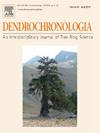X-ray micro-CT pipeline for large-scale tree-ring densitometry studies
IF 2.7
3区 农林科学
Q1 FORESTRY
引用次数: 0
Abstract
Tree-ring data provides essential insights into historical climate conditions and current ecosystem dynamics. Wood density measurements complement traditional tree-ring width series by extracting additional climatic information embedded within tree rings, with maximum latewood density serving as the gold standard for summer temperature reconstructions. However, the labor-intensive wood sample preparation required by conventional techniques is one of the main factors limiting the more widespread use of tree-ring densitometry. X-ray micro-computed tomography (XμCT) offers a novel, non-destructive, 3D densitometry technique that enables the simultaneous study of tree-ring width and wood density at high resolution and with minimal sample preparation. Despite its potential, the lack of a streamlined and time-efficient XμCT workflow has hindered its broader application in the past. Here we present a highly optimized XμCT pipeline aimed at large-scale tree-ring densitometry studies, capable of processing large amounts of increment cores with a low demand for human labor time (2.2–5.4 min per 35 cm sample length). Key parts include large and efficient sample holders (16–48 samples per scan), optimized and standardized scan settings (helical XμCT at 15, 30, and 60 μm voxel size), and three custom software packages (facilitating scan processing, ring indication, and cross-dating). Overall, this XμCT toolchain represents a significant leap forward in high-resolution tree-ring densitometry, enabling large-scale studies with a wide spatial extent, high replication, and/or long temporal range.
用于大规模树木年轮密度测定研究的x射线微ct管道
树木年轮数据提供了对历史气候条件和当前生态系统动态的重要见解。木材密度测量通过提取树木年轮中嵌入的额外气候信息来补充传统的树木年轮宽度系列,最大晚期木材密度作为夏季温度重建的黄金标准。然而,传统技术所需的劳动密集型木材样品制备是限制树木年轮密度测定法更广泛使用的主要因素之一。x射线微计算机断层扫描(XμCT)提供了一种新颖的、非破坏性的3D密度测量技术,能够以高分辨率和最少的样品制备同时研究树木年轮宽度和木材密度。尽管其潜力巨大,但由于缺乏流线型和高效的XμCT工作流程,阻碍了其在过去的广泛应用。在这里,我们提出了一个高度优化的XμCT管道,旨在大规模的树木年轮密度测量研究,能够处理大量的增量岩心,而对人力劳动时间的需求很低(2.2-5.4 min / 35 cm样品长度)。关键部件包括大而高效的样品夹(每次扫描16-48个样品),优化和标准化的扫描设置(螺旋XμCT在15,30和60 μm体素尺寸),以及三个定制软件包(便于扫描处理,环指示和交叉年代测定)。总的来说,这个XμCT工具链代表了高分辨率树木年轮密度测定的重大飞跃,实现了大空间范围、高重复性和/或长时间范围的大规模研究。
本文章由计算机程序翻译,如有差异,请以英文原文为准。
求助全文
约1分钟内获得全文
求助全文
来源期刊

Dendrochronologia
FORESTRY-GEOGRAPHY, PHYSICAL
CiteScore
5.50
自引率
13.30%
发文量
82
审稿时长
22.8 weeks
期刊介绍:
Dendrochronologia is a peer-reviewed international scholarly journal that presents high-quality research related to growth rings of woody plants, i.e., trees and shrubs, and the application of tree-ring studies.
The areas covered by the journal include, but are not limited to:
Archaeology
Botany
Climatology
Ecology
Forestry
Geology
Hydrology
Original research articles, reviews, communications, technical notes and personal notes are considered for publication.
 求助内容:
求助内容: 应助结果提醒方式:
应助结果提醒方式:


